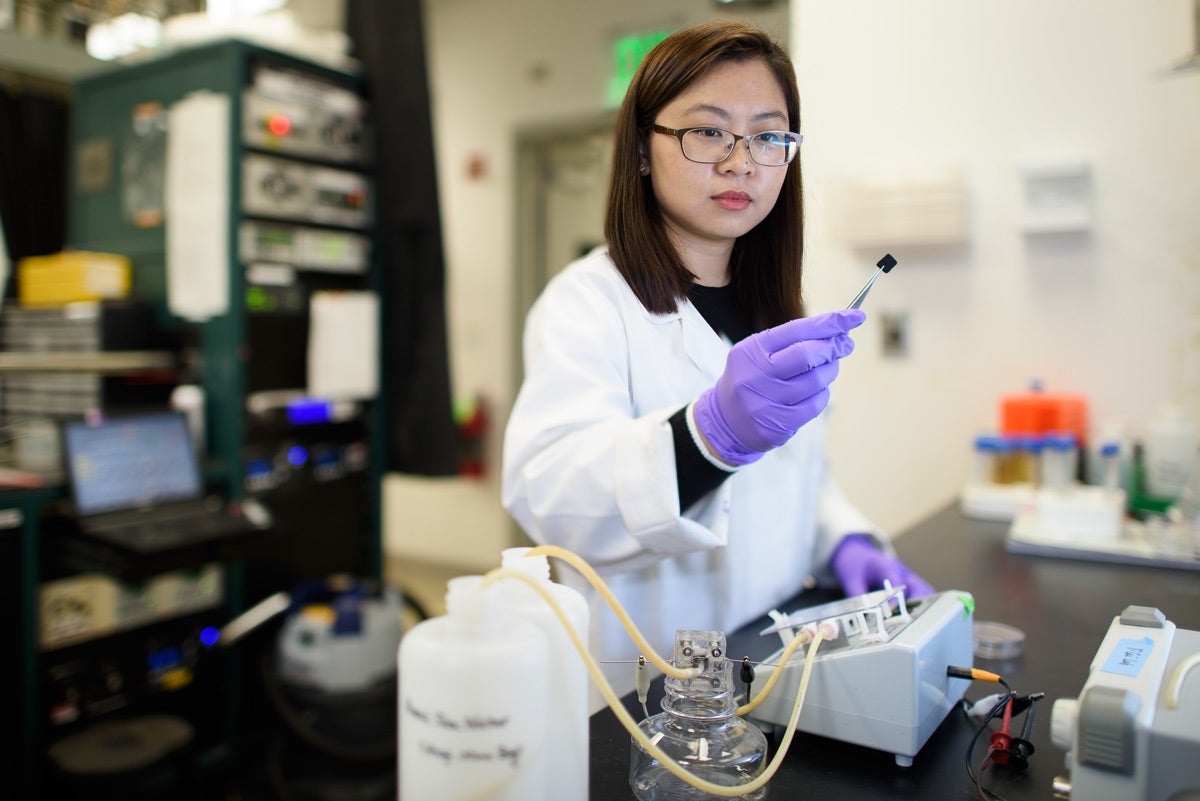Stanford researchers say extracting uranium from seawater could help nuclear power play a larger role in a carbon-free energy future
As the world shifts from fossil fuels, additional sources of energy-on-demand will be needed to make up for lulls in wind or solar. A new way of extracting uranium from seawater could help even countries without uranium mines harness nuclear power in the post-carbon energy future.
Trace amounts of uranium exist in seawater, but efforts to extract that critical ingredient for nuclear power have produced insufficient quantities to make it a viable source for those countries that lack uranium mines. A practical method for extracting that uranium, which produces higher quantities in less time, could help make nuclear power a viable part of the quest for a carbon-free energy future.

Postdoctoral scholar Chong Liu examines a carbon-amidoxime electrode as part of research to improve extraction of uranium from seawater. (Image credit: L.A. Cicero)
“Concentrations are tiny, on the order of a single grain of salt dissolved in a liter of water,” said Yi Cui, a materials scientist and co-author of a paper in Nature Energy. “But the oceans are so vast that if we can extract these trace amounts cost effectively, the supply would be endless.”
Alternative forms of energy like wind or solar are critical for reducing the world’s carbon emissions. While wind and solar costs are plunging, some experts argue that nuclear power remains important because it can be turned on and off to match peaks and valleys in demand without carbon emissions.
“We need nuclear power as a bridge toward a post-fossil-fuel future,” said Professor Steven Chu, a Nobel Prize-winning physicist and co-author of the Nature Energy article. “Seawater extraction gives countries that don’t have land-based uranium the security that comes from knowing they’ll have the raw material to meet their energy needs.”
Chu, a former U.S. secretary of energy who encouraged seawater extraction research before he left the Department of Energy (DOE) to return to Stanford, observed that nuclear power currently generates 20 percent of U.S. electricity and 13 percent worldwide. Even as researchers work to improve reactor safety and solve the waste disposal issues, he believes that a practical way to extract uranium from seawater is needed to reduce the energy insecurity of nations that depend on nuclear power but lack uranium within their own borders.
Improved extraction
The Stanford findings build on years of research in Japan and China, as well as by DOE scientists at Oak Ridge National Laboratory and the Pacific Northwest National Laboratory.
Scientists have long known that uranium dissolved in seawater combines chemically with oxygen to form uranyl ions with a positive charge. Extracting these uranyl ions involves dipping plastic fibers containing a compound called amidoxime into seawater. The uranyl ions essentially stick to the amidoxime. When the strands become saturated, the plastic is chemically treated to free the uranyl, which then has to be refined for use in reactors just like ore from a mine.
How practical this approach is depends on three main variables: how much uranyl sticks to the fibers; how quickly ions can be captured; and how many times the fibers can be reused.
In the recent work, the Stanford researchers improved on all three variables: capacity, rate and reuse. Their key advance was to create a conductive hybrid fiber incorporating carbon and amidoxime. By sending pulses of electricity down the fiber, they altered the properties of the hybrid fiber so that more uranyl ions could be collected.
Better, faster, longer lived
Postdoctoral scholar Chong Liu oversaw the lab tests that compared Stanford’s amidoxime-carbon hybrid fibers with today’s amidoxime fibers. First she tested how much uranyl each type of fiber could hold before reaching saturation. In these tests she found that by the time the standard amidoxime fiber had become saturated, Stanford’s amidoxime-carbon hybrid fibers had already adsorbed 9 times as much uranyl and were still not saturated. What’s more, the electrified fiber captured three times as much uranyl during an 11-hour test using seawater from Half Moon Bay, about an hour from Stanford, and had three times the useful lifespan of the standard amidoxime.
“We have a lot of work to do still but these are big steps toward practicality,” Cui said.
Chu emphasized that research on seawater extraction has to proceed in parallel with reactor safety and waste disposal challenges. “For much of this century, some fraction of our electricity will need to come from sources that we can turn on and off. I believe nuclear power should be part of that mix, and assuring access to uranium is part of the solution to carbon-free energy,” he said.
Steven Chu is the William R. Kenan Jr. Professor and professor of physics and of molecular and cellular physiology; he is a member of the Stanford Neurosciences Institute. Yi Cui is a professor of materials science and engineering; a professor of photon science at SLAC National Accelerator Laboratory; a member of Stanford Bio-X and the Stanford Neurosciences Institute; a researcher with the Stanford Institute for Materials and Energy Sciences, a joint Stanford-SLAC institute; and an affiliate of the Precourt Institute for Energy. Other co-authors include Po-Chun Hsu, Jin Xie, Jie Zhao, Tong Wu, Wei Liu and Jinsong Zhang, all from the Department of Materials Science and Engineering at Stanford; and Haotian Wang, formerly of the Department of Applied Physics at Stanford and now at Harvard’s Rowland Institute. Funding for this research came in part from the DOE Office of Nuclear Energy.
